Atkinson K. An Introduction to Numerical Analysis
Подождите немного. Документ загружается.

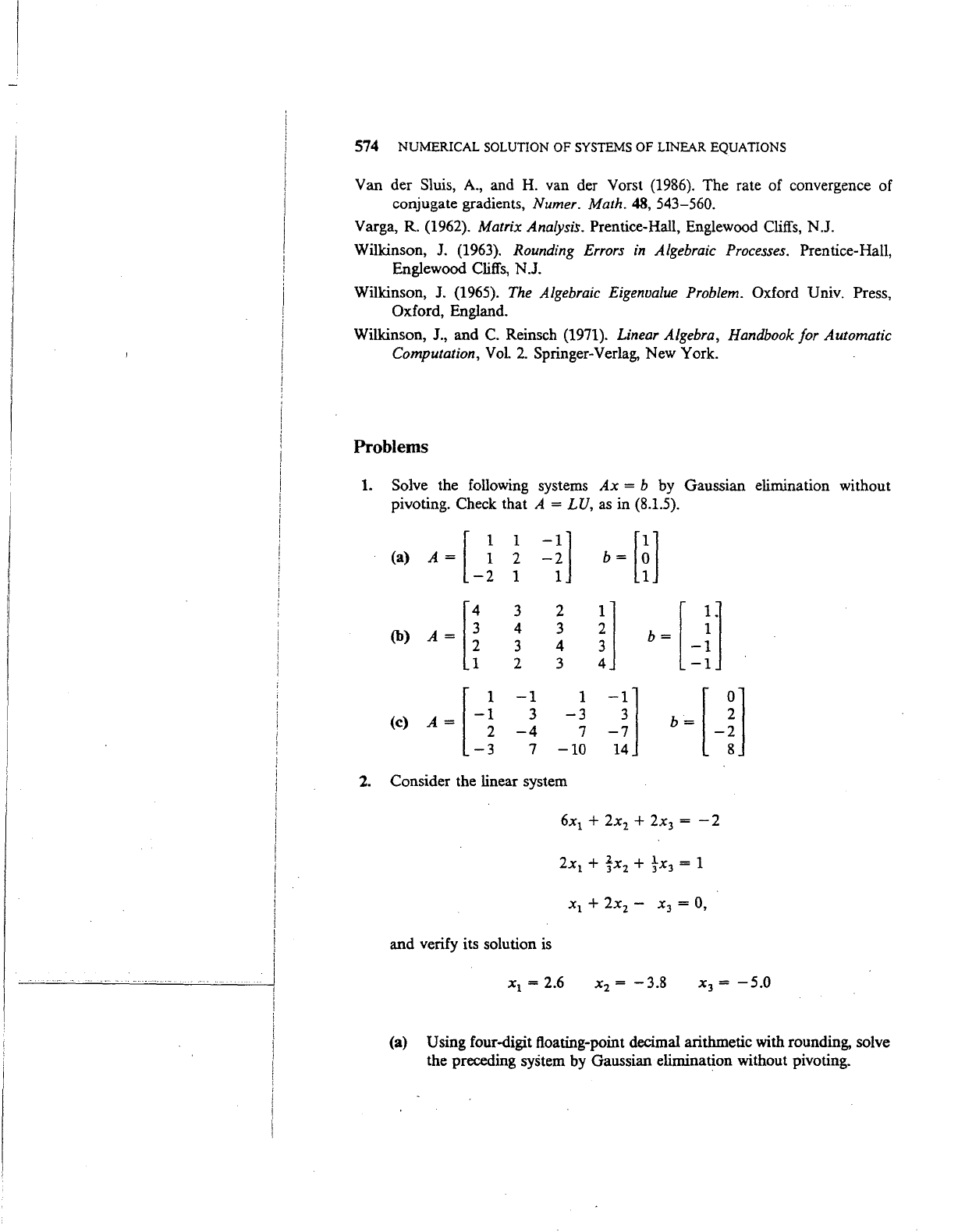
574
NUMERICAL SOLUTION OF SYSTEMS OF LINEAR EQUATIONS
Van
der
Sluis, A., and H. van der Vorst (1986). The rate of convergence
of
conjugate gradients, Numer. Math. 48, 543-560.
Varga, R. (1962). Matrix Analysis. Prentice-Hall, Englewood Cliffs, N.J.
Wilkinson, J. (1963). Rounding Errors
in
Algebraic
Processes.
Prentice-Hall,
Englewood Cliffs, N.J.
Wilkinson, J. (1965).
The
Algebraic Eigenvalue Problem. Oxford Univ. Press,
Oxford, England.
Wilkinson, J., and
C.
Reinsch (1971). Linear Algebra, Handbook for Automatic
Computation,
Vol.
2.
Springer-Verlag, New York.
Problems
1.
Solve the following systems
Ax
= b by Gaussian
elimination without
pivoting. Check that A =
LV,
as
in
(8.1.5).
A~
[ :
1
-1]
b-m
(a)
2
-2
-2
1
1
A~[~
3 2
!]
b~
[=~1
(b)
4
3
3
4
2
3
[
_:
-1
1
-~
l
b
~
[
-~]
(c)
3
-3
A=
2
-4
7
-7
-3
7
-10
14
2. Consider the linear system
and
verify its solution is
x
2
=
-3.8
x
3
=
-5.0
(a) Using four-digit floating-point decimal arithmetic with rounding, solve
the preceding system by Gaussian elimination without pivoting.
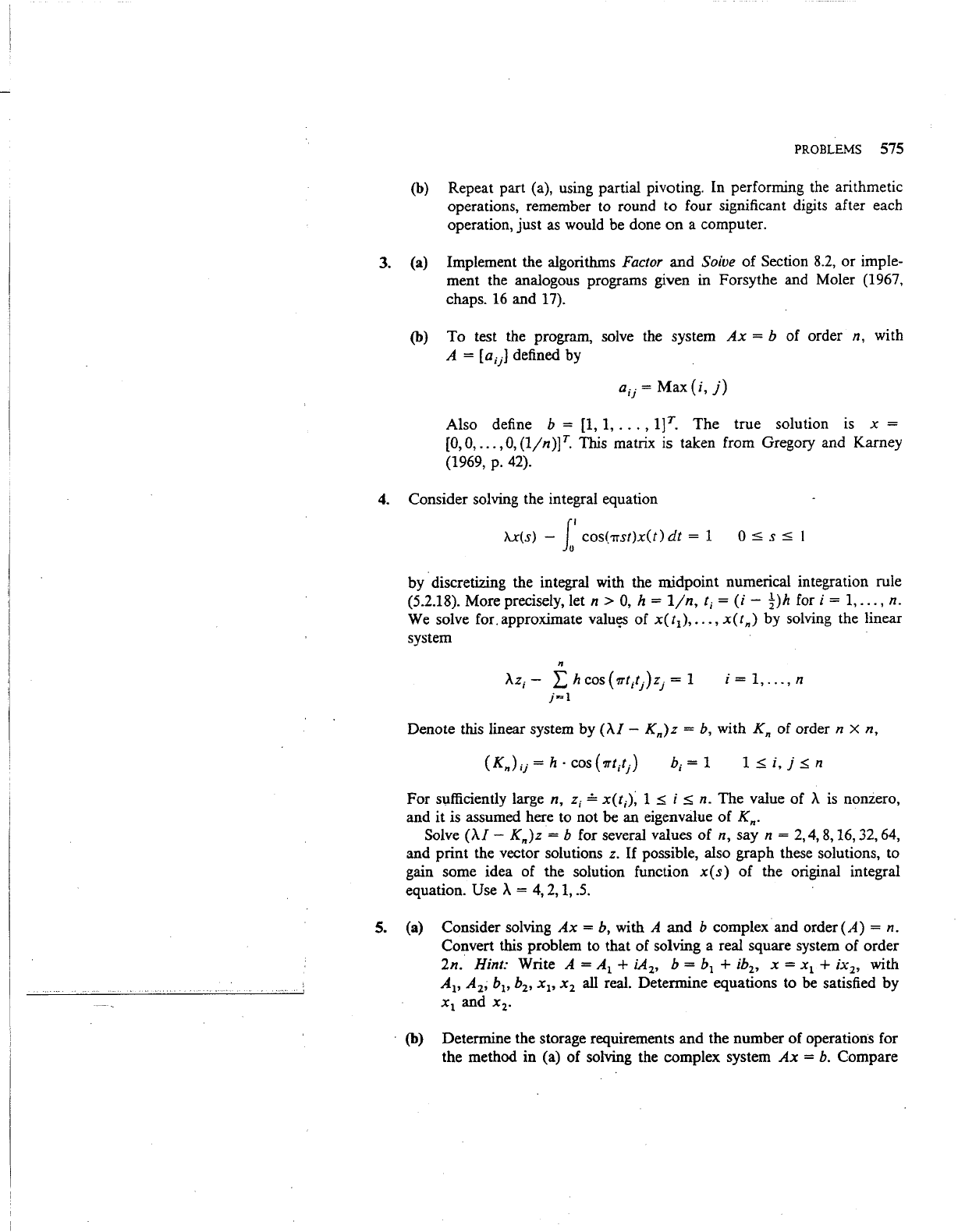
PROBLEMS 575
(b) Repeat part (a), using partial pivoting. In performing the arithmetic
operations, remember to round to four significant digits after each
operation,
just
as would be done
on
a computer.
3.
(a) Implement the algorithms
Factor
and
Soive
of
Section 8.2,
or
imple-
ment the analogous programs given in Forsythe and Moler (1967,
chaps.
16
and 17).
(b)
To
test the program, solve the system
Ax=
b of order n, with
A =
[a;)
defined by
a;j = Max (i,
j)
Also define b =
[1,
1,
...
, 1]r.
The
true solution
is
x =
[0,
0,
...
,
0,
(1/n)f.
This matrix is taken from Gregory and Karney
(1969, p. 42).
4.
Consider solving the integral equation
A.x(s)-
L'
cos(-rrst)x(t)dt
= 1
O:::;s:::;J
by discretizing the integral with the midpoint numerical integration rule
(5.2.18). More precisely, let n >
0,
h =
ljn,
I;
=
(i
-
t)h
fori
=
1,
...
,
n.
We
solve for. approximate
valut?S
of
x(t
1
),
•..
,
x(tn)
by solving the linear
system
n
>..z;-
I:
h cos ( '1Tt;tj)zj = 1
j~l
i = 1,
...
, n
Denote this linear system by
(AI-
Kn)z
= b, with Kn
of
order n X
n,
b; = 1
1
~
i,
j
~
n
For
s1,dficiently
large n,
z;
= x(t;); 1
~
i
~
n. The value
of
>..
is nonzero,
and
it
is assumed here to not be an eigenvalue
of
K
n·
Solve
(>..!
-
Kn)z
= b for several values
of
n, say n =
2,
4,
8,
16, 32,
64,
and print the vector solutions
z.
If
possible, also graph these solutions, to
gain some idea of the solution function
x(s)
of
the original integral
equation. Use
>..
=
4,
2,
1,
.5.
5.
(a) Consider solving
Ax=
b, with A
and
b complex and
order(A)
= n.
Convert this problem to that of solving a real square system of order
2n. Hint: Write A
=AI
+
iA
2
,
b = bi + ib
2
,
x =
xi
+
ix
2
,
with
AI, A
2
;
b
1
,
b
2
,
xi, x
2
all real. Detennine equations to be satisfied by
xi
and x
2
•
(b) Determine the storage requirements and the number
of
operations for
the method in (a)
of
solving the complex system
Ax=
b.
Compare

576
NUMERICAL
SOLUTION OF SYSTEMS
OF
LINEAR EQUATIONS
these results with those based on directly solving
Ax
= b using
Gaussian elimination and complex arithmetic. Note
the greater ex-
pense of complex arithmetic operations.
6.
Let A, B, C be matrices of orders m X n, n X
p,
p X
q,
respectively. Do an
operations count for computing
A(BC)
and
(AB)C.
Give examples of
when one order of computation
is
preferable over the other.
7. (a) Show that the number of multiplications and divisions for the
Gauss-Jordan method of Section
8.3
is
about
tn
3
•
(b) Show how the Gauss-Jordan method, with partial pivoting, can be
used to invert an
n X n matrix within only
n(n
+
1)
storage loca-
tions.
~an
complete pivoting be used?
8.
Use either the programs of Problem 3(a) or the Gauss-Jordan method to
invert the matrices
in Problems 1 and 3(b).
9. Prove that if
A = LLT with L real and nonsingular, then A
is
symmetric
and positive definite.
·
10.
Using the Choleski method, calculate the decomposition A =
LLr
for
[
2.25
(a)
-3.0
4.5
-3.0
5.0
-10.0
4.5]
-10.0
34.0
(b)
[
15
-18
15
-3
-18
24
-18
4
15
-18
18
-3
11.
Let A be nonsingular. Let. A =
LU
=
LDM,
with all l;;,
mu
=
1,
and D
diagonal. Further assume A
is
symmetric. Show
that
M = Lr, and thus
A
=
LDe.
Show A
is
positive definite if and only if all
d;;
>
0.
12. Let A be real, symmetric, positive definite, and of order n. Consider solving
Ax
= b using Gaussian elimination without pivoting. The purpose of this
problem is to justify that the pivots will be nonzero.
(a) Show that
all of the diagonal elements satisfy
a;;
>
0.
This shows that
a
11
can be used
as
a pivot element.
(b) After elimination of x
1
from equations 2 through n, let the resulting
matrix
A<
2
> be written as ·
1<2).
Show that
1<
2
>·.is
symmetric and positive definite.

PROBLEMS
577
This procedure can be continued inductively to each stage
of
the
elimination process, thus justifying
~he
existence
of
nonzero pivots
at
every
step. Hint: To prove
A<
2
l
is
positive definite, first prove the identity
for any choice of x
1
,
x
2
,
•••
, xn. Then choose x
1
suitably.
13.
As.
another approach to developing a compact method for producing the
LV
factorization
of
A, consider the following matrix-oriented approach.
Write
A=
[A
d]
CT a
C,
d E
Rn
-
1
a E R
and
A square of order n -
1.
Assume A
is
nonsingular. As a step in an
induction process, assume
A=
LO
is known, .with A nonsingular. Look
for A =
LU
in
the
form
A=[L
o][o
q]
mT
1 0 Y
m,
q E Rn-
1
y E R
Show that
m,
q,
and y can be found,
and
describe how to do so. (This
method is applied to an original A, factoring each principal submatrix in
the
upper
left corner, in increasing order.)
14. Using the algorithm (8.3.23)-(8.3.24) for solving tridiagonal systems, solve
Ax=
b with
A=[~
. 0
0
-1
2
1
0
0
0
-1
2
1
0
0
0
-1
2
1
~]
-b
=
[-~]
-1
-2
2 1
Check that the hypotheses and conclusions
of
Theorem 8.2 are satisfied by
this example.
15.
Define the order n tridiagonal matrix
2
-1
0
0
-1
2
-1
0
A =
0
-1
2
-1
n
0
-1
2
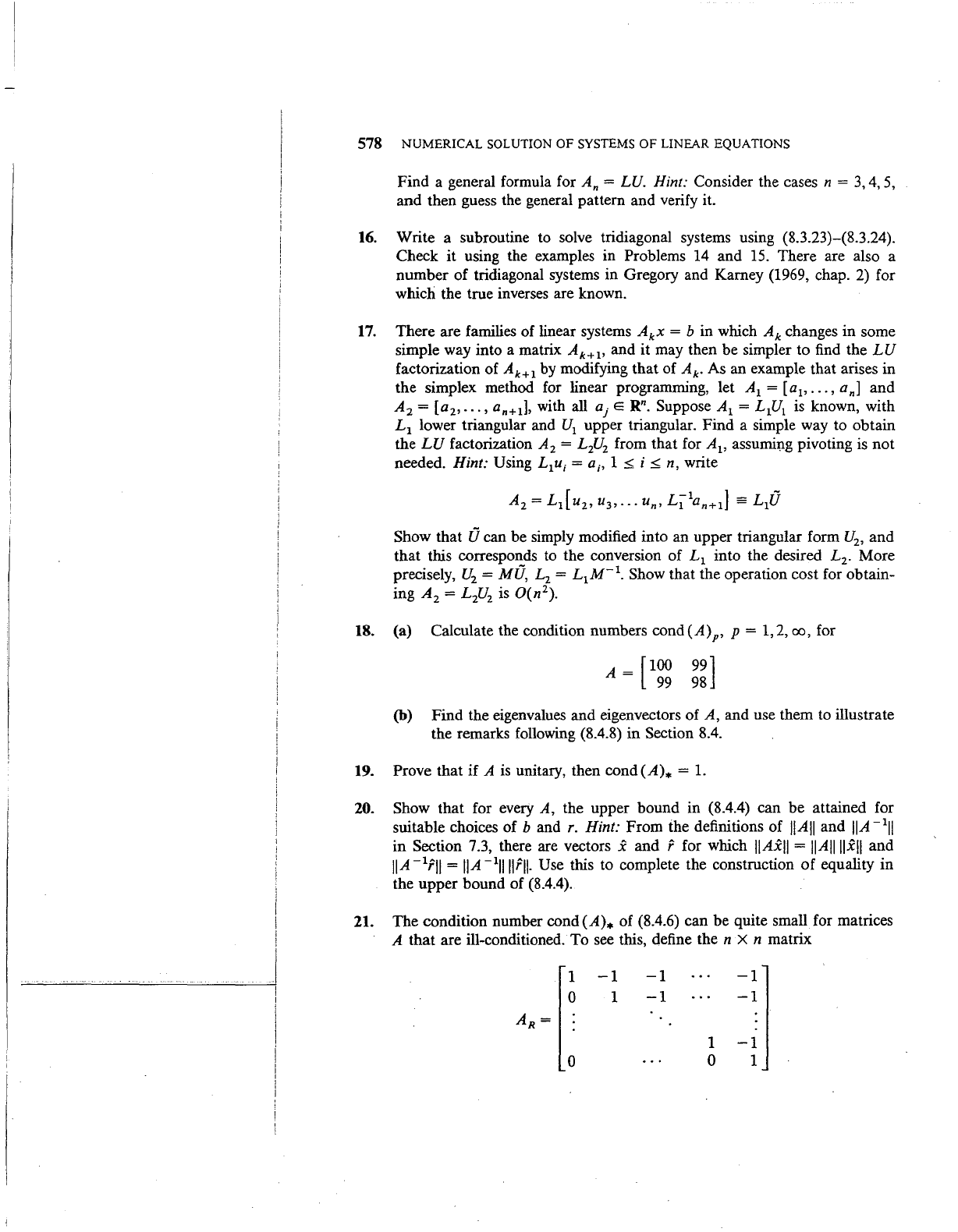
578 NUMERICAL SOLUTION
OF
SYSTEMS
OF
LINEAR EQUATIONS
Find
a general formula for
An
= LU. Hint: Consider the cases n =
3,
4,
5,
and
then guess the general pattern
and
verify it.
16.
Write a subroutine to solve tridiagonal systems using (8.3.23)-(8.3.24).
Check
it
using the examples in Problems 14
and
15. There are also a
number
of
tridiagonal systems in Gregory and Karney (1969, chap. 2) for
which the true inverses are known.
17.
There
are families
of
linear systems
Akx
= b in which Ak changes
in
some
simple way into a matrix Ak+
1
,
and
it may then
be
simpler to find the
LU
factorization of Ak+
1
by modifying
that
of Ak. As an example that arises in
the
simplex method for linear programming, let A
1
=
[a
1
,
•..
,
an]
and
A
2
=
[a
2
,
••.
,
an+d,
with all
aj
ERn.
Suppose A
1
= L
1
U
1
is known, with
L
1
lower triangular and U
1
upper triangular.
Find
a simple way to obtain
the
LU
factorization A
2
=
LP
2
from
that
for A
1
,
assumiJ;lg
pivoting is
not
needed. Hint: Using L
1
u;
=a;,
1 s
is
n, write
Show that 0 can
be
simply modified into
an
upper triangular form U
2
,
and
that
this corresponds to the conversion
of
L
1
into the desired L
2
•
More
precisely, U
2
=
MU,
L
2
= L
1
M-
1
•
Show that the operation cost for obtain-
ing A
2
=
Lp
2
is O(n
2
).
18. (a) Calculate the condition numbers cond
(A)
P'
p = 1,
2,
oo,
for
A =
[100
99]
99
98
(b)
Find
the eigenvalues
and
eigenvectors
of
A,
and use them to illustrate
the remarks following (8.4.8)
in
Section 8.4.
19. Prove
that
if
A is unitary, then
cond(A)*
= 1.
20. Show
that
for every A, the upper bound
in
(8.4.4) can
be
attained for
suitable choices
of
b and
r.
Hint:
From
the definitions of
IIAII
and
IIA
-
1
11
in
Section 7.3, there are vectors
.X
and
f for which
IIA.XII
=
IIAIIII.XII
and
IIA
-Ipll =
IIA
-
1
1111fll.
Use this to complete the construction
of
equality
in
the
upper
bound
of
(8.4.4).
21. The condition number
cond(A)*
of (8.4.6) can
be
quite small for matrices
A
that
are ill-conditioned.
To
see this, define the n X n matrix
1
-1
-1
-1
0
1
-1
-1
AR
=
1
-1
0
0 1
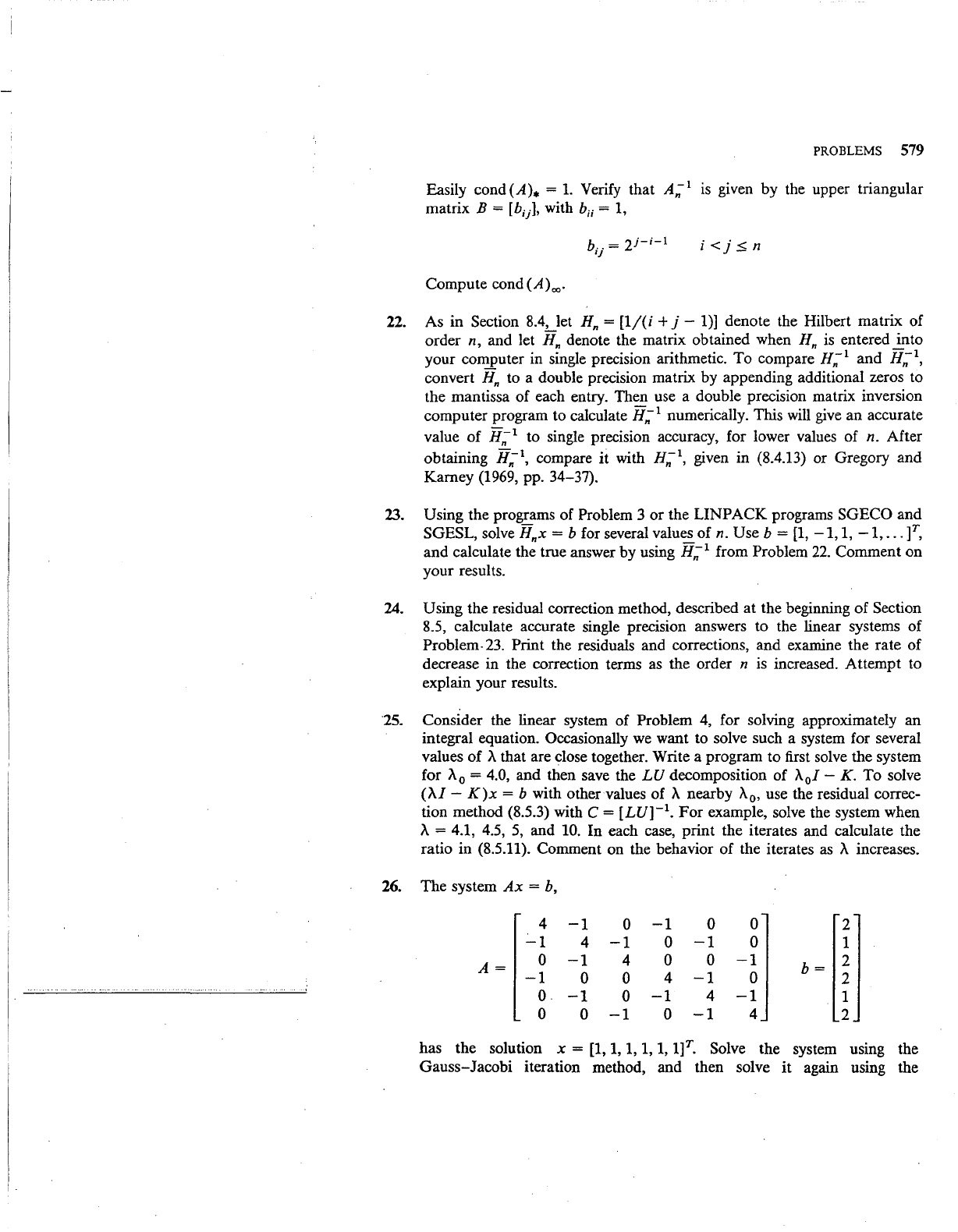
PROBLEMS 579
Easily
cond(A).
=
1.
Verify that
A,;-
1
is
given by the upper triangular
matrix
B = [b;j], with
b;;
=
1,
b .. =
2j-i-1
,,
i<j:Sn
Compute cond(A)
00
•
22. As in Section
8.4,
let
Hn
=
[lj(i
+
j-
1)]
denote the Hilbert matrix of
order
n,
and let
lin
denote the matrix obtained when
Hn
is
entered into
your computer in single precision arithmetic. To compare
H,;-
1
and
ii;\
convert
lin
to a double precision matrix by appending additional zeros to
the mantissa of each entry. Then use a double precision matrix inversion
computer program to calculate
H,-
1
numerically. This will give an accurate
value of
ii,;-
1
to single precision accuracy, for lower values of n. After
obtaining
Hn-1,
compare it with
H;\
given in (8.4.13) or Gregory and
Karney
(1969,
pp. 34-37).
23.
Using the programs of Problem 3 or the
UNPACK
programs SGECO and
SGESL, solve
Jinx
= b for several values of n. Use b =
[1,
-1,
1,
-1,
...
f,
and calculate the true answer by using
H;
1
from Problem
22.
Comment on
your results.
24.
Using the residual correction method, described at the beginning of Section
8.5, calculate accurate single precision answers to the linear systems of
Problem-
23.
Print the residuals and corrections, and examine the rate of
decrease in the correction terms as the order
n
is
increased. Attempt to
explain your results.
25. Consider the linear system of Problem
4,
for solving approximately an
integral equation.
Occasionally we want to solve such a system for several
values of
A that are close together. Write a program to first solve the system
for
A
0
= 4.0, and then save the
LU
decomposition of A
0
J-
K.
To solve
(AI-
K)x
= b with other values of A nearby A
0
,
use the residual correc-
tion method (8.5.3) with
C =
[LU]-
1
•
For
example, solve the system when
A = 4.1,
4.5,
5,
and
10.
In each case, print the iterates and calculate the
ratio in (8.5.11). Comment on the behavior of the iterates
as
A increases.
26. The system
Ax=
b,
4
-1
0
-1
0 0
2
~1
4
-1
0
-1
0
1
A=
0
-1
4 0
0
-1
b=
2
-1
0 0
4
-1
0
2
0
-1
0
-1
4
-1
1
0 0
-1
0
-1
4
2
has the
solution
X =
[1,
1,
1,
1,
1,
If.
Solve the
system using the
Gauss-Jacobi
iteration
method, and
then solve
it again using the

580 NUMERICAL SOLUTION OF SYSTEMS
OF
LINEAR EQUATIONS
Gauss-Seidel method. Use the initial guess
x<
0
l =
0.
Note the rate at which
the iteration error decreases. Find the answers with an accuracy
of£
= .0001.
27. Let A and B have order n, with A nonsingular. Consider solving the linear
system
(a) Find necessary and sufficient conditions for convergence of the itera-
tion method
m~O
(b) Repeat part (a) for the iteration method
m
~
0
Compare the convergence rates of the
two
methods.
28.
For the error equation (8.6.25), show that
r"(M)
< 1 if
1
for some matrix norm.
29.
For
the iteration of a block tridiagonal systems, given in (8.6.30), show
convergence under the assumptions that
I I I
IIC"I
<
IIB~-111;
IIAAI
+
IIC;II
<
IIB;-111'
2 :s i :s r -
I;
IIA~I
<
IIB,-111
Bound the rate of convergence.
30. Recall the matrix
An
of Problem 15, and consider the linear system
Anx
= b. This system
is
important as it arises in the standard finite
difference approximation (6.11.30) to the two-point boundary value prob-
lem
y"(x)
=
f(x,
y(x))
a<x</3
y(a)
= a
0
y(/3)
=at
It is also important because it arises in the analysis of iterative methods for
solving
discretiuitions·of Poissons equation, as in (8.8.5).
In
line with this,·
consider using Jacobi's method to solve
Anx
= b iteratively. Show that
Jacobi's method converges by showing
r"(M)
< 1 for the appropriate
matrix M. Hint:
Use the results of Problem 6 of Chapter
7.
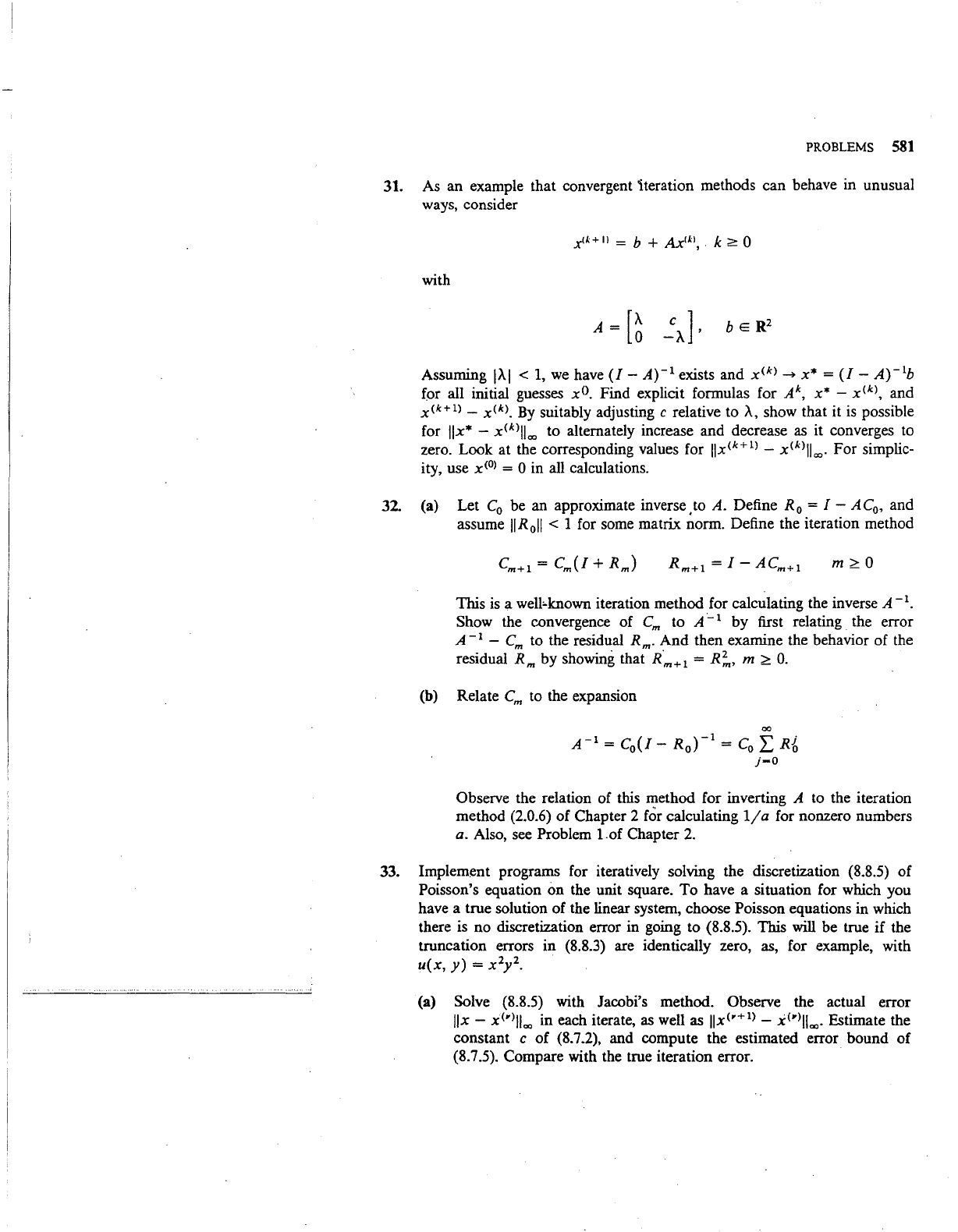
PROBLEMS
581
31. As an example that convergent 1teration methods can behave
in
unusual
ways, consider
with
Assuming
jAj <
1,
we
have(/-
A)-
1
exists and
x<k>-+
x*
=
(/-
A)-
1
b
(or all initial guesses
x<>.
Find explicit formulas for
Ak,
x*
-
x<k>,
and
x<k+l)-
x<k>.
By
suitably adjusting c relative to
A,
show that it
is
possible
for
llx*
-
x<k>lloo
to alternately increase and decrease
as
it converges to
zero. Look at the corresponding values for
jjx<k+l)-
x<k>lloo·
For simplic-
ity, use
x<
0
> = 0 in all calculations.
32. (a) Let
C
0
be an approximate inverse ,to A. Define R
0
=
I-
AC
0
,
and
assume
IIRoll
< 1 for some matrix norm. Define the iteration method
m
~0
This
is
a
well~known
iteration method for calculating the inverse A
-l.
Show the convergence of
Cm
to
A:.._
1
by first relating the error
A
-l
-
Cm
to the residual Rm. And then examine the behavior of the
. . 2
residual
Rm
by
showing that Rm+l =
Rm,
m
~
0.
(b)
Relate
Cm
to the expansion
00
A-
1
= C
0
{l-
R
0
)-
1
= C
0
L
Rb
j-0
Observe the relation of this method for inverting A to the iteration
method (2.0.6) of Chapter 2
for calculating
1/a
for nonzero numbers
a. Also, see Problem
l.of
Chapter
2.
33. Implement programs for iteratively solving the discretization (8.8.5) of
Poisson's equation
on the unit square. To have a situation for which you
have a true solution of the linear system, choose Poisson equations in which
there
is
no discretization error in going to (8.8.5). This
will
be true if the
truncation errors in (8.8.3) are identically zero, as, for example, with
u(x,
y)
= x
2
y
2
•
(a) Solve (8.8.5) with Jacobi's method. Observe the actual error
llx-
x<•>u.,.,
in each iterate, as
well
as
ux<•+l)-
.x<•>uoo·
Estimate the
constant
c of (8.7.2), and compute the estimated error bound of
(8.7.5). Compare with the true iteration error.
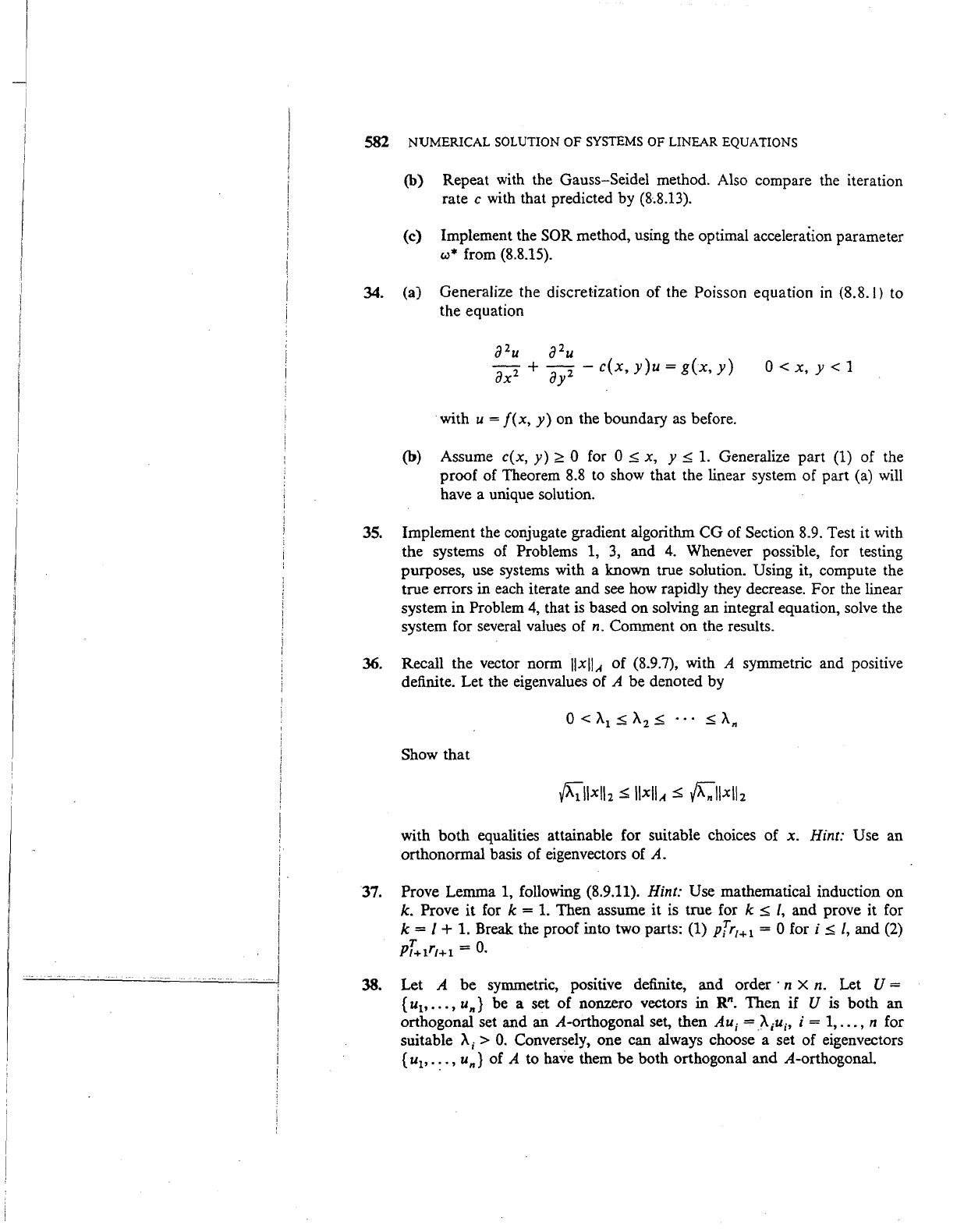
582 NUMERICAL SOLUTION OF SYSTEMS OF LINEAR EQUATIONS
(b) Repeat with the Gauss-Seidel method. Also compare the iteration
rate c with that predicted by (8.8.13).
(c) Implement the SOR method, using the optimal acceleration parameter
w*
from
(8.8.15).
34. (a) Generalize the discretization
of
the Poisson equation
in
(8.8.1) to
the equation
0
<X,
y < 1
with u =
f(x,
y)
on the boundary as before.
(b) Assume c(x,
y)
2::
0 for 0
.::;;
x,
y.::;;
1.
Generalize
part
(1)
of
the
proof
of
Theorem 8.8 to show that the linear system
of
part
(a) will
have a unique solution.
35. Implement the conjugate gradient algorithm
CG
of Section 8.9. Test it with
the
systems of Problems
1,
3,
and
4.
Whenever possible, for testing
purposes, use systems with a known true solution. Using it, compute the
true errors
in
each iterate
and
see how rapidly they decrease.
For
the linear
system
in
Problem
4,
that is based
on
solving an integral equation, solve the
system for several values of n. Comment
on
the results.
36. Recall the vector norm
llxll,o~
of
(8.9.7), with A symmetric and positive
definite. Let the eigenvalues
of
A
be
denoted by
Show
that
with
both
equalities attainable for suitable choices
of
x. Hint: Use
an
orthonormal basis of eigenvectors
of
A.
37. Prove Lemma
1,
following (8.9.11). Hint: Use mathematical induction
on
k. Prove
it
for k =
1.
Then assume
it
is true for k
.::;;
/,
and
prove it for
k
=I+
1. Break the proof into two parts: (1) p[r
1
+
1
= 0 fori.::;;
I,
and (2)
PT+l,/+1
=
0.
38. Let A
be
symmetric,
pos1Uve
definite, and
order·
n X n. Let U =
{ u
1
,
...
,
un}
be a set
of
nonzero vectors
in
Rn.
Then
if
U is
both
an
orthogonal set
and
an A-orthogonal set, then
Au;=
]\;U;,
i =
1,
...
, n for
suitable
A;>
0. Conversely, one can always choose a set
of
eigenvectors
{ u
1
, . : . , u
n}
of
A to have them
be
both orthogonal
and
A -orthogonal.
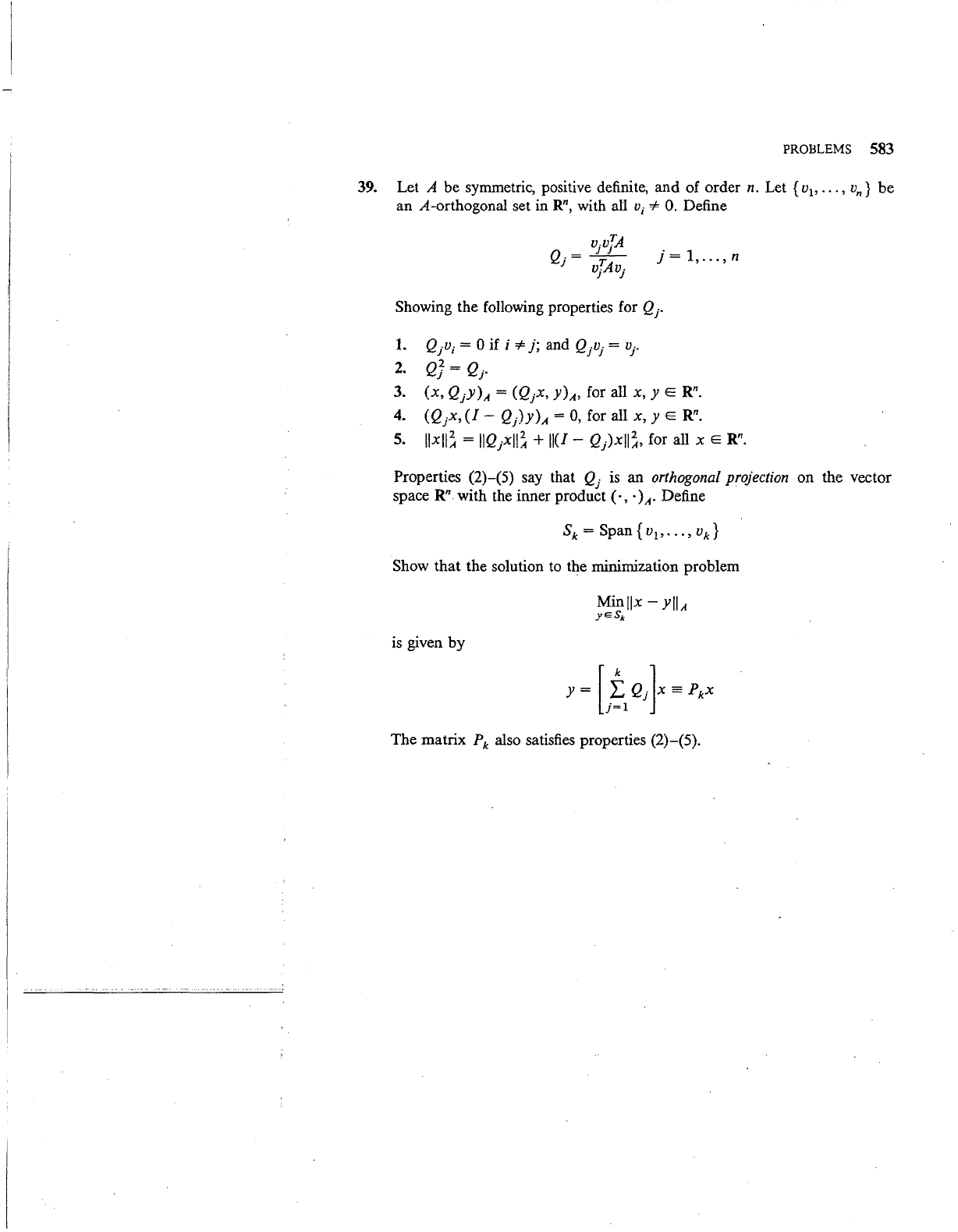
PROBLEMS 583
39. Let
A be symmetric, positive definite, and of order
n.
Let { v
1
,
...
,
vn}
be
an A-orthogonal set
in
Rn,
with all V;
i=
0.
Define
j = 1,
...
, n
Showing the following properties for Q P
1.
Q
1
v;
= 0 if i
i=
j;
and Q
1
v
1
= v
1
.
2.
Q] =
Qj.
3.
(x,
Q
1
y)A
=
(Q
1
x,
y)A,
for all x, y
ERn.
4.
(Q
1
x,(I-
Q)y)A
=
0,
for all
x,
y
ERn.
5.
llxll~
=
IIQ
1
xll~
+
II(/-
Q)xll~,
for all x E
Rn.
Properties (2)-(5) say that Q
1
is an orthogonal projection on the vector
space
R"
with the inner product (
·,
·)A· Define
Show that the solution to the minimization problem
is
given by
The matrix
Pk
also satisfies properties (2)-(5).
